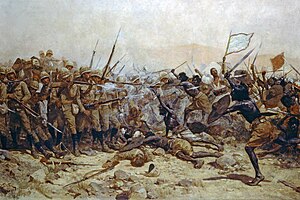Battle of Abu Klea
| date | January 17, 1885 |
|---|---|
| place | Abu Klea, 50 km north of Schandi ( Sudan ) |
| output | British victory |
| Parties to the conflict | |
|---|---|
|
Ansar (Mahdists) |
|
| Commander | |
|
Mûsâ wad Hilu † |
|
| Troop strength | |
| approx. 1,500 | about 10,000 |
| losses | |
|
76 men |
about 1,100 men |
Aba - Jebel Gedir I - Sennar I - Jebel Gedir II - al-Ubayyid I - al-Ubayyid II - Sennar II - Sinkat - Sheikan - First Battle of El Teb - Second Battle of El Teb - Tamanieh - Khartoum - Abu Klea - Gallabat - Toski - Firket - Atbara - Omdurman - Umm Diwaykarat
In the battle of Abu Klea in Sudan on January 17, 1885, a British army under Herbert Stewart defeated the supporters of Mahdi Muhammad Ahmad .
prehistory
In Sudan, which came under the rule of the Ottoman viceroys ( Khedives ) of Egypt from 1821, the Mahdi uprising began in 1881. The colonial forces of Great Britain, which occupied Egypt in 1882, were primarily focused on the conflict with Russia at the time. Due to the dire situation of the Egyptian troops in Sudan, the British government under Gladstone ordered Egypt in December 1883 to give up the Sudan provinces. However, this was difficult in that thousands of Egyptian soldiers, civilian employees and their relatives had to be evacuated from Sudan. The British government therefore commissioned Charles George Gordon , who had been Governor of Sudan from 1877 to 1880, to go to Khartoum to organize the evacuation from there. Gordon reached Khartoum on February 18, 1884 and was able to bring about 2500 women, children, the sick and wounded to Egypt to safety before the Mahdists enclosed the city on March 18 and began the ten-month siege of Khartoum . Gladstone finally gave in and sent an army under Garnet Joseph Wolseley , called the Gordon Relief Expedition . However, this was not ready to march until November 1884. In December the troops reached Korti .
course
While the main British armed forces ( River Column ), under Major General William Earle (after his death Henry Brackenbury ) were to advance from Korti by steamers on the Nile, the so-called Camel Corps marched directly through the desert under Stewart. On December 30, 1884, Stewart began his 185-mile march towards Metemmeh with 1,600 men and 2,400 camels. On January 3, 1885, he reached the wells of Gakdul. Two small forts were erected here and the troops waited for reinforcements and supplies, increasing them to 1,800 men. On January 13th the advance continued.
On January 16, the Camel Corps encountered an army of Mahdists near Abu Klea. This was formed from the siege army off Khartoum and from members of the Jaalin tribe. As it was very late, Stewart had a fortified camp built. During the night there were isolated shots, but otherwise both sides spent the night quietly. On the morning of January 17th, both sides expected the other side to attack their fortified camp. Stewart ended this situation by creating a large square and trying to bypass the Mahdist camp. Before he could do that, however, the British square was attacked by two columns of mahdists, each 5000 strong. Stewart and his 1,500 men were able to beat the 10,000 Mahdists who were organizationally inferior. The British lost nine officers (including Lt. Col. Frederick Gustavus Burnaby , the deputy commander and Edward John Leveson Jervis, 4th Viscount St. Vincent ) and 65 soldiers. Two officers later died from their wounds. Together with the more than 90 wounded, the Camel Corps lost ten percent of its population. 1100 bodies of fallen Mahdists could be counted on the battlefield.
The Camel Corps advanced on Metemmeh and was attacked at Gubat on January 19th. Stewart was fatally wounded and gave command to Sir Charles Wilson. It reached Khartoum two days after the city fell. Stewart lived long enough to be named major-general and died on the way back from Khartoum to Korti.
literature
- W. Dennistoun Sword, Henry SL Alford: Egyptian Soudan. Its loss and recovery. With Records of the Services of the Officers (1896-8) . Macmillan, London et al. 1898, (Reprinted by Naval & Military Press Ltd, Uckfield 2001, ISBN 1-84342-100-3 ).
- Michael Barthorp: Blood-red desert sand. The British Invasions of Egypt and the Sudan 1882-98 . Cassell Military Trade Books, London 2002, ISBN 0-304-36223-9 .

